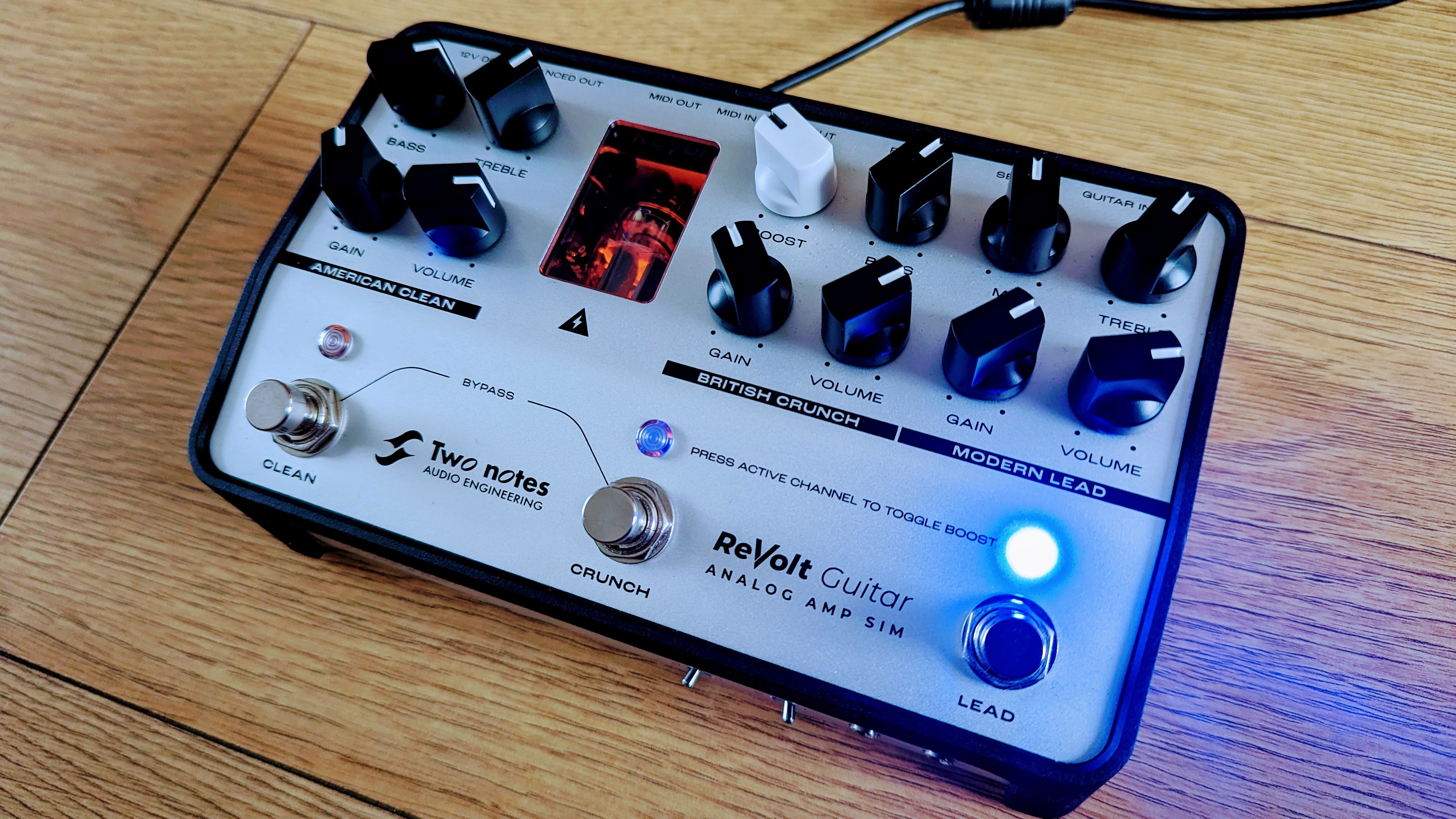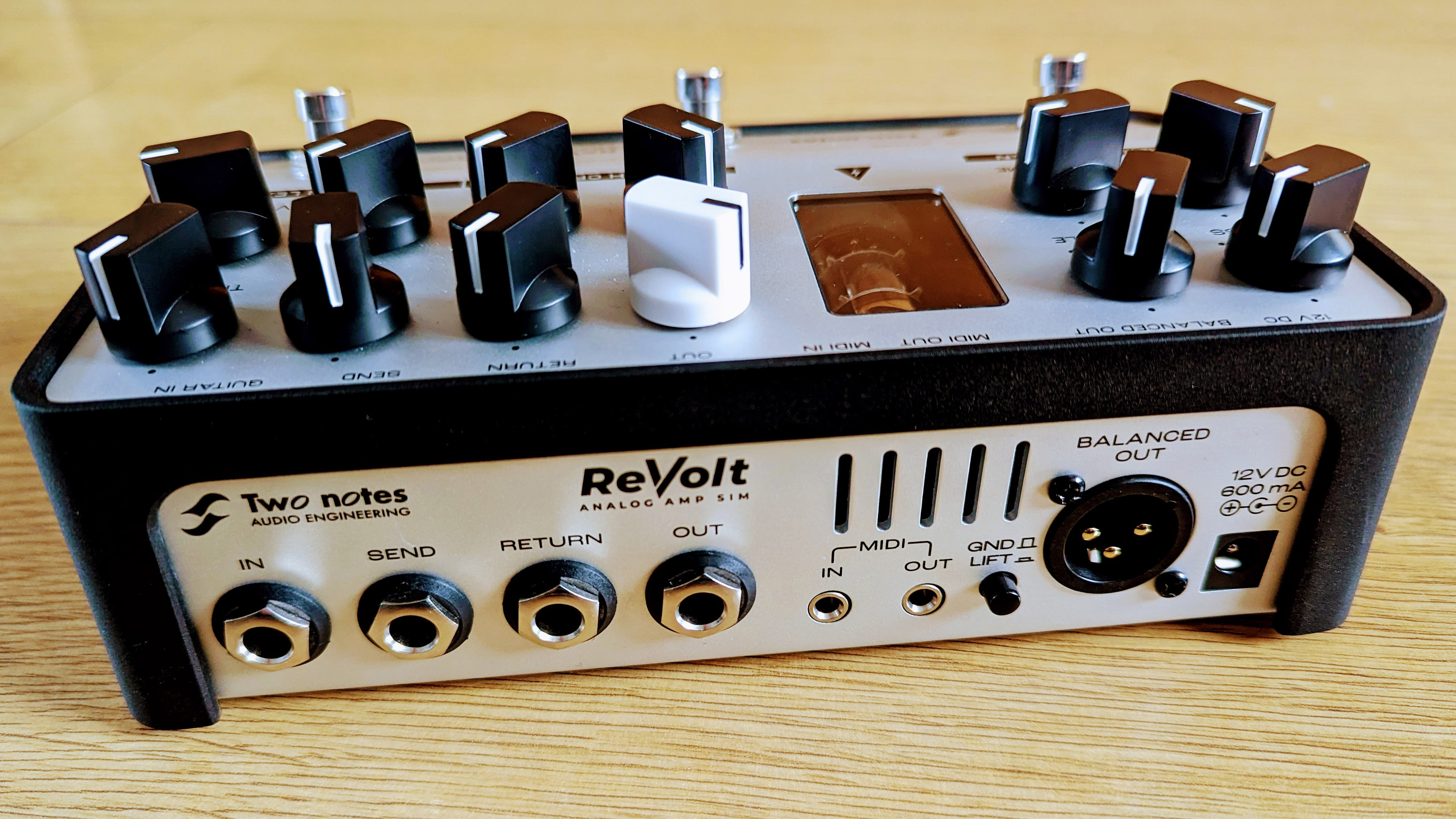MusicRadar Verdict
Expand your amp's potential or pair with a cab modeller and build your pedalboard around it; this three-channel unit delivers an impressive preamp option in the growing world of floor-based solutions.
Pros
- +
Three distinct preamp channels in a compact unit
- +
Allows you to upgrade the scope of your existing amp
- +
MIDI can control other devices and vice versa
Cons
- -
Only a shared three-band EQ for channels two and three
- -
Onboard cab sim isn't great – IRs get the best from this
MusicRadar's got your back
Two Notes ReVolt Guitar: What is it?

Two Notes Audio Engineering has carved out an impressive reputation as a world leader in cab emulation, load boxes and attenuators for studio and stage, but its foray into the burgeoning amp pedal market isn't digital.
This isn't the company's first rodeo in the preamp pedal business; the Le Clean, Le Crunch, Le Lead and Le Bass pedals were warmly received seven years ago. The ReVolt Guitar and ReVolt Bass take that idea further. Indeed, the 'triple threat' here, as Two Notes call it, combines the iconic amp territories explored in the trio of Le pedals for a three-channel preamp pedal.
ReVolt Guitar (there's also a bass model) has a 12AX7 preamp tube inside running at 200V. Valve warmth and DI flexibility for live, headphone fun and recording is the proposition here. Can the French team pull it off?
Two Notes ReVolt Guitar: Performance and verdict

There are three footswitches for the American Clean, British Crunch and Modern Lead here; inspired by an iconic trio of Fender Bassman 100, Marshall JMP Super Lead and Soldano SLO 100.
A clear layout even gives us instructions on how to activate up to +20db boost on each channel; simply press the active channel's footswitch again (the valve in its little window will be lit red). This boost control is shared by all three channels, less of an issue for us than the fact the Crunch and Lead channels share a three-band EQ, while the Clean has its own two-band. Some compromise is therefore required when it comes to dialling in EQ to switch between channels two and three.
Nevertheless, the three channels and boosts give impressive scope for a wide tonal territory here. And the ways we can use this pedal underline that versatility. We test into a Fender Deluxe combo, an FRFR cab using the Two Notes onboard analogue cab sim and with third-party IRs. We also try it with the four-cable method to utilise the power amp section of a Fender Mustang modelling amp and give it a tube upgrade. Oh, and we also try it for recording via Logic with a Two Notes digital element; its Wall Of Sound plugin gives ReVolt owners ten different cabs to use.
There are a lot of scenarios to try here!
Want all the hottest music and gear news, reviews, deals, features and more, direct to your inbox? Sign up here.

While Two Notes makes one of the best pedal platform cab modellers out there with the Torpedo C.A.B. M+, the company has committed to an all-analogue signal path with ReVolt and that includes the onboard cab sim, based on a signature Marshall Slash 4x12. Its inclusion gives you scope to go DI at a gig through the balanced XLR out, but it's not the best way to use ReVolt in our experience of testing it with an FRFR cab.
In comparison with the impulse responses we loaded onto our Line 6 Powercab (including a '64 Fender Deluxe, Celestion Greenback and Mesa/ Boogie cab with a Celestion V30), plus going into a real Fender Deluxe and using the four-cable method (the pedal features a designated switch on the front to optimise it for this) with our Mustang, the Two Notes analogue cab sim felt more compressed with less of the valve vibrancy we enjoyed in the other scenarios.
Like any good overdrive pedal, a decent clean platform can allow details to shine. And that's the case here with these three preamp channels, which bodes well for anyone looking to expand the scope of an amp with headroom.

The American Clean channel lives up to its name and provides an excellent, warm platform for boost pedals like our Wampler Tumnus, and unless your pickups are coming in particularly hot, it won't break up without the engagement of an external pedal or its own boost circuit. The boost's mid-bump alongside its saturation is great for cutting through, but also a handy way of transitioning more fluidly to the next ReVolt channel.
The Super Lead-influenced Crunch channel takes over where the boosted Clean maxes out, and it's pairing these two that became a go-to for us. The SLO-inspired Lead will be a destination for both heavier fare and sustained fuzz-like lead, but the Classic also offers scope to explore those realms when paired with external overdrives. We really enjoyed hearing what it could offer on its own too; serious classic rock grunt and girth!
Because of the shared EQ we often found it easier to pair off the first two channels and balance them in song scenarios, but for higher gain territory, the Modern Lead helps the ReVolt cover an impressively wide tonal landscape that responded well to our guitars' volume controls.

The commitment to an analogue signal path here doesn't come at the cost of connectivity; in addition to the FX loop that you'll ideally want for tour reverb and delay pedals, there's MIDI IN/OUT for remote control – and it can be used to control other MIDI pedals.
The lack of onboard reverb may disappoint some, and we especially miss it when using the headphones out alongside the onboard cab sim, but Two Notes are open about this being a rig's foundation for players to build around and have clearly tried to make it as compact as possible while offering enough physical controls.
That concept of ReVolt as an essential component for pairing applies to the power stage; it's undeniable that the ideal scenario to fully explore and utilise the tones here would be a designated IR platform of which the company's Torpedo C.A.B. M + is a market-leading example.
The ReVolt can't be used as a USB audio interface itself, but alongside our Universal Audio Volt with Logic Pro we were able to further explore the potential of pairing it with Two Notes' cabinet technology via 10 included Series-G DynOr Cabinet Collection captures. These are inspired by cabs including a Peavey 2x12, Marshall and Mesa/Boogie 4x12s and a Fender 2x12.
The Two Notes Torpedo Wall Of Sound software gives you plenty of parameters to explore including mic type and distance, a choice of room, compression and much more. The combination with ReVolt helps it to shine as a source for your recorded tones and suggests the potential pairing with the CAB M+ could be a powerful combination of analogue and digital Two Notes tech.

ReVolt Guitar is an unapologetically analogue offering in a varied and fast-evolving market. Whether pre-, power-amp or both, all amp pedals offer flexibility, but their features are distinct to give players the choice for their specific needs. Here, three distinct amp channels serve an analogue preamp feast with gain tones leaning towards vintage classic rock and heavy rock.
MusicRadar verdict: Expand your amp's potential or pair with a cab modeller and build your pedalboard around it; this three-channel unit delivers an impressive preamp option in the growing world of floor-based solutions.
Two Notes ReVolt Guitar: Hands-on demos
Andertons
Peter Thorn
Sweetwater
Brett Kingman
Two Notes
Leo Gibson
Two Notes ReVolt Guitar: Specifications

Type: Three-channel analogue preamp pedal with 12AX7 preamp tube
Controls: Boost, American Clean channel: fooswitch, Bass, Treble, Gain, Volume; British Crunch channel: footswitch, Gain, Volume; Modern Lead channel: footswitch, Gain, Volume; British Crunch and Modern Lead shared EQ: Bass, Mid, Treble; Ground lift, four-cable method on/off, analogue cab sim on/off
Connectivity: 1/4" In / Out, MIDI In / Out, Balanced Out, Effects loop, Send/Return, aux in, headphone out
Power: 12V DC (600mA draw)
Dimensions: 192mm (w) x 117mm (D) x 70mm (H) 7
Contact: Two Notes

Rob is the Reviews Editor for GuitarWorld.com and MusicRadar guitars, so spends most of his waking hours (and beyond) thinking about and trying the latest gear while making sure our reviews team is giving you thorough and honest tests of it. He's worked for guitar mags and sites as a writer and editor for nearly 20 years but still winces at the thought of restringing anything with a Floyd Rose.
